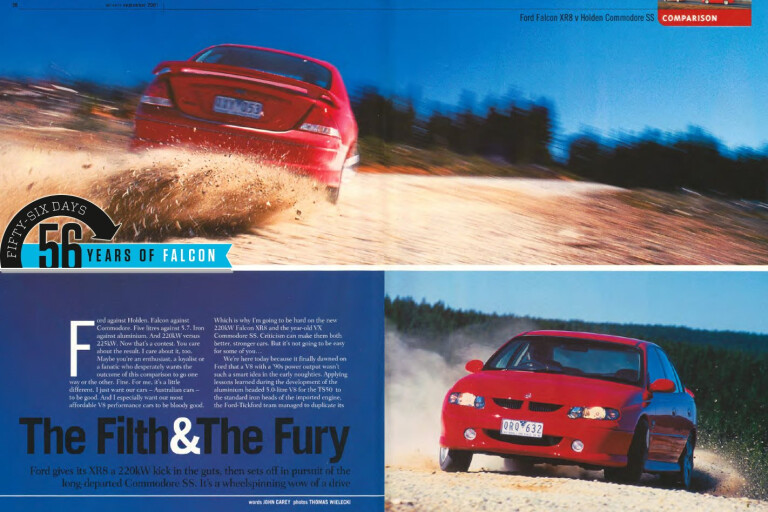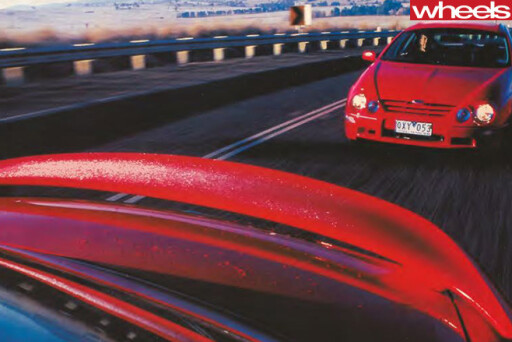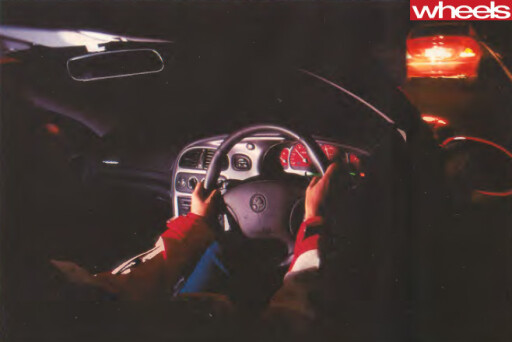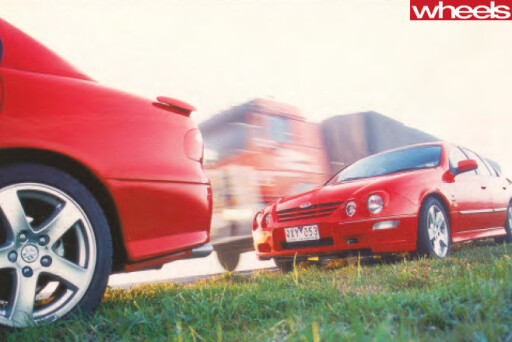
First published in the September 2001 issue of Wheels magazine, Australia's best car mag since 1953.
Ford gives its XR8 a 220kW kick in the guts, then sets off in pursuit of the long-departed Commodore SS. It’s a wheelspinning wow of a drive.
Ford against Holden. Falcon against Commodore. Five litres against 5.7. Iron against aluminium. And 220kW versus 225kW. Now that’s a contest. You care about the result. I care about it, too. Maybe you’re an enthusiast, a loyalist or a fanatic who desperately wants the outcome of this comparison to go one way or the other.
Fine. For me, it’s a little different. I just want our cars – Australian cars – to be good. And I especially want our most affordable V8 performance cars to be bloody good. Which is why I’m going to be hard on the new 220kW Ford Falcon XR8 and the year-old VX Commodore SS.
Criticism can make them both better, stronger cars. But that’s not going to be easy for some of you …
We’re here today because it finally dawned on Ford that a V8 with a ’90s power output wasn’t such a smart idea in the early noughties. Applying lessons learned during the development of the aluminium headed 5.0-litre V8 for the TS50 to the standard iron heads of the imported engine, the Ford-Tickford team managed to duplicate its 220kW output.
 Commodore SS drivers should worry, because the XR8 is now a 14-point-something second car. Just like theirs. The Ford’s vital statistics are 0-100km/h in 6.6 seconds, 0-400 metres in 14.8 seconds. I’d love to tell you how much faster or slower the SS Holden Commodore is, but I can’t.
Commodore SS drivers should worry, because the XR8 is now a 14-point-something second car. Just like theirs. The Ford’s vital statistics are 0-100km/h in 6.6 seconds, 0-400 metres in 14.8 seconds. I’d love to tell you how much faster or slower the SS Holden Commodore is, but I can’t.
Why? Our bloody Correvit fell off. At something like 150km/h. So there I was with a couple of kilos of very expensive German microwave sensor being dragged up he bitumen at the end of its cable, with computer operating co-pilot Adam Porter making anguished noises in the passenger seat. Not only because, like me, he could imagine how expensive this mishap might prove. No, Porter was also preventing the sensor dragging the rest of the performance testing hardware through the window by clutching the cable connecting the sensor head to the small Correvit signal processing box in the footwell which was, in turn, linked to the computer on his lap.
I got hard into the brakes, but not too hard. Didn’t want to make things even worse by having the bouncing Correvit sensor catch up with the car to be run over.
There wasn’t too much damage to the SS. A shallow dent in the left rear door, near the doorhandle, was the worst of it. As well, there were a couple of superficial grazes to the rear quarter panel and bumper. The completed insurance form is in the mail. Good luck with it Holden. And sincere apologies.
But the Correvit was ugly. The microwave sensor’s machined aluminium casing has been badly ground and gouged. The sheathing of the cable had been rubbed through in several places. And the magnetic mat we’ve used for years without mishap to attach the microwave sensor to the side of all sorts of cars was mangled. Off to Correvit hospital for the whole sorry mess. And no SS standing start performance data.
 This disaster occurred during our second attempt at performance testing the XR8 and SS. First time out it rained. We got good in-gears rolling start data. Traction isn’t an issue in the rolling increments, but a damp strip obviously means standing start times are far from representative. Just to give you an idea, the XR8 was seven tenths of a second slower 0-100km/h in the wet than dry.
This disaster occurred during our second attempt at performance testing the XR8 and SS. First time out it rained. We got good in-gears rolling start data. Traction isn’t an issue in the rolling increments, but a damp strip obviously means standing start times are far from representative. Just to give you an idea, the XR8 was seven tenths of a second slower 0-100km/h in the wet than dry.
It’s illuminating to compare the 220kW XR8’s dry strip standing start acceleration to the last SS we tested. One year ago the VT Series II SS ran 0-100km/h in 6.9 seconds and 0-400 metres in 15.0 seconds.
And no, I haven’t forgotten that Holden’s 5.7-litre V8 received an additional five kilowatts with the transformation from VT Series II to VX last year, but a piffling two percent power increase isn’t going to have a major impact on performance. These old SS figures are very slightly slower than the new XR8 delivered.
There’s no way I’m going to call it one way or another. Not when we don't have data recorded on the same day at the same place with the same driver. What is abundantly clear is that the XR8is now in the same performance league as the SS when it comes to a straight drag race.
In normal driving, however, the Holden engine's additional cubic centimetres and superior torque give it a slight edge in responsiveness in third, fourth and fifth gears. The gearing of the two cars is very similar all the way from first through to fifth.
The big difference is, of course, that the Holden has a sixth slot. It's not a completely useless gear, although it is remarkably tall. Sixth delivers more than 65km/h per 1000 engine revs. Put another way, 110km/h equals about 1600rpm.
The XR8's top gear, in contrast, means 110km/h equals 2400rpm.
 On flat country roads the SS wafts along with only slight pressure on the accelerator pedal. While the Holden will climb gentle grades in sixth, actual acceleration demands a downchange.
On flat country roads the SS wafts along with only slight pressure on the accelerator pedal. While the Holden will climb gentle grades in sixth, actual acceleration demands a downchange.
Or two.
I'm not sure that anyone interested in cars like the XR8and SS cares much about fuel consumption.
But you're going to hear about it anyway. The Holden's sixth gear does deliver a decided advantage in country cruising. The SS's best figure on this test of 8.2litres/100km is amazingly good, especially considering it burns regular 91 octane unleaded and the Ford requires premium 95. Even so, the XR8’s best of 9.2 litres/100km, is impressive. But drive these V8s like you've sometimes got to and the consumption gap narrows.
More often than not the Commodore will prove the more economical, but there was one hard-driven stage during our more than 1000km of testing where the XR8 beat it. What we're talking about here, with both the Ford and Holden, is consumption in the 14.0 to 16.0-litres/100km range when doing the kind of driving you enjoy and remember.
All these numbers are very interesting, but they give no sense of the quite different characters of these two drivetrains.
The SS's Gen III is a mighty effective chunk of aluminium, but it's a remote and rather uninvolving engine. Its voice is too muffled, for a start. And even at the upper end of its rev scale it doesn't communicate a feeling of eager willingness to the driver.
Part of the reason is that the accelerator pedal feels dead and heavy underfoot, at least until wheelspin invokes traction control system activity. The TC jerks about with the pedal, literally. It's a feature designed to encourage the driver to lift off.
Funny, but I thought that's what the TC electronics were supposed to do.
 Despite this criticism, the SS's engine is better than its manual transmission. The US-made T56 six speeder is an awful old thing that Holden should cease buying. Now.
Despite this criticism, the SS's engine is better than its manual transmission. The US-made T56 six speeder is an awful old thing that Holden should cease buying. Now.
Rubbery, notchy, vague, heavy and with reverse in a dopey place (out on a dogleg beyond fifth); there's not a single positive thing to say about it except that it seems to cope pretty well with 460 newton metres.
The XRS's Australian-made T5 five-speeder is better. Its chief advantage is that it isn't so rubbery. Unlike the Holden, it actually feels like the Ford's gear lever is connected to a box full of oily, whirling cogs. With a conventional five-speed gate, the placement of reverse isn't an issue.
And, finally, the XR8's clutch is a little lighter and has a deal more feel than the SS's. In just about every way that counts, this is a better manual transmission.
And the engine? What about the engine! Love it. This has got to be the dear old Windsor V8's finest hour. Cast iron may not be the fashion today, but this engine's booming responsiveness is never going to go out of style. Not until the oil runs out, anyway.
It sounds great. Suitably muted at idle and acceptably quiet at cruise speed revs, the 5.0-litre begins to sing as the needle swings past 3000. By 4000 it's V8 Supercar soundtrack. Low-pitched exhaust from behind, high-pitched mechanical whine up front. While the red on the tach dial starts at 5750, the Ford V8 feels eager to spin harder all the way to the rather coarse cut-out at 6250.
There's only one thing I can complain about, and that's the tingling vibration that can be felt, especially through the floor, when the engine is spun into the thrill zone.
Unlike the SS, the XR8 has a light throttle pedal, which helps reinforce the impression of precise responsiveness. It's a recurring theme in the Ford. The steering, likewise, is light, consistent and precise.And firm feeling brakes are bitingly effective with only moderate pedal pressure.
Our test car was equipped with Ford's premium brake package. What this means is larger diameter front brakes and weird looking eccentric circular grooves cut in all four discs. Able to deliver dry road stopping distances from 100km/h of less than 40 metres, this is the one XR8 option you must have. Even though the cost is a steep $3050.
None of the other options in the test car – leather upholstery, Momo wheel and knob, body kit extras or in-dash six CD premium sound system; enough to push the price well beyond $50,000 off a base of $45,828 – is absolutely essential.
 The SS, too, is cohesive. In a bad way. To go with the ghastly gearbox and doughy throttle pedal, Holden adds lumpily inconsistent steering weighting and a soggy brake pedal.
The SS, too, is cohesive. In a bad way. To go with the ghastly gearbox and doughy throttle pedal, Holden adds lumpily inconsistent steering weighting and a soggy brake pedal.
While the brakes, despite their feel, are competitively effective, the steering can sometimes behave strangely. Flinging the Holden sideways on dirt (traction control switched off, obviously), I found that getting the rear wheels spinning caused a startling decline in the level of assistance. It made what should have been fun damned hard work.
No such problem with the Ford. From the driver's seat it's a stark comparison between SS and XR8. The SS feels blunt-edged, desperately in need of a thorough sharpening.
Get past the marked differences in quality of the car-to-driver interface and the actual chassis dynamics of the two are not dissimilar. Both have a firm, but not too firm, ride. On second-rate rural roads they feel right at home, in control no matter how holed and heaved the surface may be.
The SS does tend to understeer a little more than the XR8, during both the turn-in and power-out phases of cornering. And the Ford also enjoys a small advantage when it comes to directional transitions. With its slightly superior roll control the Ford is the better tool for stringing corners together in a smoothly fluent sequence.
The new XR8, then, is a winner. It's a much more rewardingly responsive drive than the SS, and now delivers similarly thrilling performance. Ford has ended the reign of the Gen III-engined SS as king of the affordable Australian V8-performance cars.
Deny it if you like. But that's your problem, not mine.
 Ford against Holden. Falcon against Commodore. Five litres against 5.7. Iron against aluminium. And 220kW versus 225kW. Now that’s a contest. You care about the result. I care about it, too. Maybe you’re an enthusiast, a loyalist or a fanatic who desperately wants the outcome of this comparison to go one way or the other.
Ford against Holden. Falcon against Commodore. Five litres against 5.7. Iron against aluminium. And 220kW versus 225kW. Now that’s a contest. You care about the result. I care about it, too. Maybe you’re an enthusiast, a loyalist or a fanatic who desperately wants the outcome of this comparison to go one way or the other.
Fine. For me, it’s a little different. I just want our cars – Australian cars – to be good. And I especially want our most affordable V8 performance cars to be bloody good. Which is why I’m going to be hard on the new 220kW Falcon XR8 and the year-old VX Commodore SS.
Criticism can make them both better, stronger cars. But that’s not going to be easy for some of you …
We’re here today because it finally dawned on Ford that a V8 with a ’90s power output wasn’t such a smart idea in the early noughties. Applying lessons learned during the development of the aluminium headed 5.0-litre V8 for the TS50 to the standard iron heads of the imported engine, the Ford-Tickford team managed to duplicate its 220kW output.
Commodore SS drivers should worry, because the XR8 is now a 14-point-something second car. Just like theirs. The Ford’s vital statistics are 0-100km/h in 6.6 seconds, 0-400 metres in 14.8 seconds. I’d love to tell you how much faster or slower the SS Commodore is, but I can’t.
Why? Our bloody Correvit fell off. At something like 150km/h. So there I was with a couple of kilos of very expensive German microwave sensor being dragged up he bitumen at the end of its cable, with computer operating co-pilot Adam Porter making anguished noises in the passenger seat. Not only because, like me, he could imagine how expensive this mishap might prove. No, Porter was also preventing the sensor dragging the rest of the performance testing hardware through the window by clutching the cable connecting the sensor head to the small Correvit signal processing box in the footwell which was, in turn, linked to the computer on his lap.
I got hard into the brakes, but not too hard. Didn’t want to make things even worse by having the bouncing Correvit sensor catch up with the car to be run over.
There wasn’t too much damage to the SS. A shallow dent in the left rear door, near the doorhandle, was the worst of it. As well, there were a couple of superficial grazes to the rear quarter panel and bumper. The completed insurance form is in the mail. Good luck with it Holden. And sincere apologies.
But the Correvit was ugly. The microwave sensor’s machined aluminium casing has been badly ground and gouged. The sheathing of the cable had been rubbed through in several places. And the magnetic mat we’ve used for years without mishap to attach the microwave sensor to the side of all sorts of cars was mangled. Off to Correvit hospital for the whole sorry mess. And no SS standing start performance data.
This disaster occurred during our second attempt at performance testing the XR8 and SS. First time out it rained. We got good in-gears rolling start data. Traction isn’t an issue in the rolling increments, but a damp strip obviously means standing start times are far from representative. Just to give you an idea, the XR8 was seven tenths of a second slower 0-100km/h in the wet than dry.
It’s illuminating to compare the 220kW XR8’s dry strip standing start acceleration to the last SS we tested. One year ago the VT Series II SS ran 0-100km/h in 6.9 seconds and 0-400 metres in 15.0 seconds.
And no, I haven’t forgotten that Holden’s 5.7-litre V8 received an additional five kilowatts with the transformation from VT Series II to VX last year, but a piffling two percent power increase isn’t going to have a major impact on performance. These old SS figures are very slightly slower than the new XR8 delivered.
There’s no way I’m going to call it one way or another. Not when we don't have data recorded on the same day at the same place with the same driver. What is abundantly clear is that the XR8is now in the same performance league as the SS when it comes to a straight drag race.
In normal driving, however, the Holden engine's additional cubic centimetres and superior torque give it a slight edge in responsiveness in third, fourth and fifth gears. The gearing of the two cars is very similar all the way from first through to fifth.
The big difference is, of course, that the Holden has a sixth slot. It's not a completely useless gear, although it is remarkably tall. Sixth delivers more than 65km/h per 1000 engine revs. Put another way, 110km/h equals about 1600rpm.
The XR8's top gear, in contrast, means 110km/h equals 2400rpm.
On flat country roads the SS wafts along with only slight pressure on the accelerator pedal. While the Holden will climb gentle grades in sixth, actual acceleration demands a downchange.
Or two.
I'm not sure that anyone interested in cars like the XR8and SS cares much about fuel consumption.
But you're going to hear about it anyway. The Holden's sixth gear does deliver a decided advantage in country cruising. The SS's best figure on this test of 8.2litres/100km is amazingly good, especially considering it burns regular 91 octane unleaded and the Ford requires premium 95. Even so, the XR8’s best of 9.2 litres/100km, is impressive. But drive these V8s like you've sometimes got to and the consumption gap narrows.
More often than not the Commodore will prove the more economical, but there was one hard-driven stage during our more than 1000km of testing where the XR8 beat it. What we're talking about here, with both the Ford and Holden, is consumption in the 14.0 to 16.0-litres/100km range when doing the kind of driving you enjoy and remember.
All these numbers are very interesting, but they give no sense of the quite different characters of these two drivetrains.
The SS's Gen III is a mighty effective chunk of aluminium, but it's a remote and rather uninvolving engine. Its voice is too muffled, for a start. And even at the upper end of its rev scale it doesn't communicate a feeling of eager willingness to the driver.
Part of the reason is that the accelerator pedal feels dead and heavy underfoot, at least until wheelspin invokes traction control system activity. The TC jerks about with the pedal, literally. It's a feature designed to encourage the driver to lift off.
Funny, but I thought that's what the TC electronics were supposed to do.
Despite this criticism, the SS's engine is better than its manual transmission. The US-made T56 six speeder is an awful old thing that Holden should cease buying. Now.
Rubbery, notchy, vague, heavy and with reverse in a dopey place (out on a dogleg beyond fifth); there's not a single positive thing to say about it except that it seems to cope pretty well with 460 newton metres.
The XRS's Australian-made T5 five-speeder is better. Its chief advantage is that it isn't so rubbery. Unlike the Holden, it actually feels like the Ford's gear lever is connected to a box full of oily, whirling cogs. With a conventional five-speed gate, the placement of reverse isn't an issue.
And, finally, the XR8's clutch is a little lighter and has a deal more feel than the SS's. In just about every way that counts, this is a better manual transmission.
And the engine? What about the engine! Love it. This has got to be the dear old Windsor V8's finest hour. Cast iron may not be the fashion today, but this engine's booming responsiveness is never going to go out of style. Not until the oil runs out, anyway.
It sounds great. Suitably muted at idle and acceptably quiet at cruise speed revs, the 5.0-litre begins to sing as the needle swings past 3000. By 4000 it's V8 Supercar soundtrack. Low-pitched exhaust from behind, high-pitched mechanical whine up front. While the red on the tach dial starts at 5750, the Ford V8 feels eager to spin harder all the way to the rather coarse cut-out at 6250.
There's only one thing I can complain about, and that's the tingling vibration that can be felt, especially through the floor, when the engine is spun into the thrill zone.
Unlike the SS, the XR8 has a light throttle pedal, which helps reinforce the impression of precise responsiveness. It's a recurring theme in the Ford. The steering, likewise, is light, consistent and precise.And firm feeling brakes are bitingly effective with only moderate pedal pressure.
Our test car was equipped with Ford's premium brake package. What this means is larger diameter front brakes and weird looking eccentric circular grooves cut in all four discs. Able to deliver dry road stopping distances from 100km/h of less than 40 metres, this is the one XR8 option you must have. Even though the cost is a steep $3050.
None of the other options in the test car – leather upholstery, Momo wheel and knob, body kit extras or in-dash six CD premium sound system; enough to push the price well beyond $50,000 off a base of $45,828 – is absolutely essential.
The SS, too, is cohesive. In a bad way. To go with the ghastly gearbox and doughy throttle pedal, Holden adds lumpily inconsistent steering weighting and a soggy brake pedal.
While the brakes, despite their feel, are competitively effective, the steering can sometimes behave strangely. Flinging the Holden sideways on dirt (traction control switched off, obviously), I found that getting the rear wheels spinning caused a startling decline in the level of assistance. It made what should have been fun damned hard work.
No such problem with the Ford. From the driver's seat it's a stark comparison between SS and XR8. The SS feels blunt-edged, desperately in need of a thorough sharpening.
Get past the marked differences in quality of the car-to-driver interface and the actual chassis dynamics of the two are not dissimilar. Both have a firm, but not too firm, ride. On second-rate rural roads they feel right at home, in control no matter how holed and heaved the surface may be.
The SS does tend to understeer a little more than the XR8, during both the turn-in and power-out phases of cornering. And the Ford also enjoys a small advantage when it comes to directional transitions. With its slightly superior roll control the Ford is the better tool for stringing corners together in a smoothly fluent sequence.
The new XR8, then, is a winner. It's a much more rewardingly responsive drive than the SS, and now delivers similarly thrilling performance. Ford has ended the reign of the Gen III-engined SS as king of the affordable Australian V8-performance cars.
Deny it if you like. But that's your problem, not mine.

COMMENTS